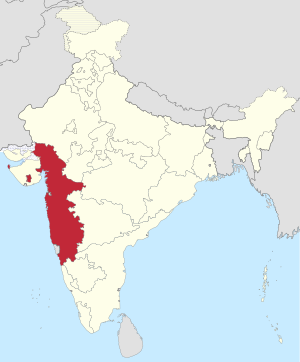
Back ولاية بومباي Arabic বোম্বে রাজ্য Bengali/Bangla Estat de Bombai Catalan Bombay (Bundesstaat) German Estado de Bombay Spanish ایالت بمبئی Persian État de Bombay French બૃહદ મુંબઇ રાજ્ય Gujarati בומביי (מדינה) HE बॉम्बे राज्य Hindi
Bombay | |||||||||||||||||||||
|---|---|---|---|---|---|---|---|---|---|---|---|---|---|---|---|---|---|---|---|---|---|
State 1950–1960 | |||||||||||||||||||||
| State of Bombay | |||||||||||||||||||||
 Location of Bombay in India | |||||||||||||||||||||
| Country | India | ||||||||||||||||||||
| Region | West India | ||||||||||||||||||||
| Formation | 1950 | ||||||||||||||||||||
| Bifurcation | 1960 (into Maharashtra and Gujarat states) | ||||||||||||||||||||
| Consolidation | 1956 (merged Kutch State, Saurashtra State and Vidarbha) | ||||||||||||||||||||
| Capital and largest city | Bombay | ||||||||||||||||||||
| Government | |||||||||||||||||||||
| • Governor | |||||||||||||||||||||
• 1950–1952 | Raja Maharaj Singh (First) | ||||||||||||||||||||
• 1956–1962 | Sri Prakasa (Last) | ||||||||||||||||||||
| • Chief minister | |||||||||||||||||||||
• 1946–1952 | Balasaheb Gangadhar Kher (First) | ||||||||||||||||||||
• 1956–1960 | Yashwantrao Chavan (Last) | ||||||||||||||||||||
| Time zone | UTC+05:30 (IST) | ||||||||||||||||||||
| |||||||||||||||||||||


Bombay State was a large Indian state created in 1950 from the erstwhile Bombay Presidency, with other regions being added to it in the succeeding years. Bombay State (British India, roughly equating to the present-day Indian state of Maharashtra, excluding Marathwada) and Vidarbha) was merged with the princely states of Baroda, Western India and Gujarat (the present-day Indian state of Gujarat) and the Deccan States (which included parts of the present-day Indian states of Maharashtra and Karnataka).
On 1 November 1956, Bombay State was re-organized under the States Reorganisation Act on linguistic lines, absorbing various territories including the Saurashtra and Kutch States, which ceased to exist. On 1 May 1960, Bombay State was dissolved and split on linguistic lines into the two states of Gujarat, with Gujarati speaking population and Maharashtra, with Marathi speaking population.[1]
- ^ Ramachandra Guha, India after Gandhi: The History of the World's Largest Democracy. HarperCollins, 2007
